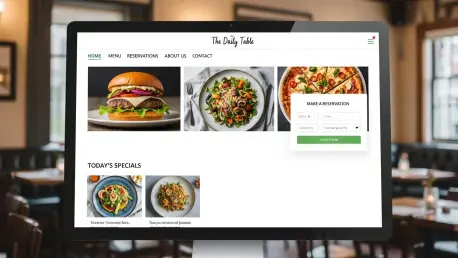In an era where digital convenience reigns supreme, imagine a world where securing a table at a favorite restaurant is as simple as a few clicks on a smartphone, even during peak dining hours. As of 2025, web-based restaurant platforms have already transformed the hospitality landscape, bridging the gap between diners and establishments with unprecedented ease. These platforms are not just tools for booking; they represent a fundamental shift in how the industry operates, enhancing customer experiences while streamlining restaurant operations. This report delves into the current state of these digital solutions, explores emerging trends, and projects their impact over the next decade up to 2035, uncovering the opportunities and challenges that lie ahead for stakeholders in this dynamic sector.
Understanding the Web-Based Restaurant Platforms Landscape
The hospitality industry in 2025 heavily relies on web-based restaurant platforms to facilitate seamless interactions between diners and establishments. These digital tools have become indispensable, offering functionalities such as online reservations, real-time availability updates, and customer feedback systems. Their role extends beyond mere convenience, enabling restaurants to optimize seating arrangements and build stronger relationships with patrons through tailored communications.
Key players like OpenTable, Resy, and TheFork dominate the market, providing robust solutions that cater to a wide range of restaurant types. Alongside these giants, emerging competitors and niche platforms are gaining traction by focusing on specialized needs, such as unique dining experiences or specific cuisines. This competitive diversity ensures that both large chains and small bistros find tools suited to their operational scale and customer base.
The significance of these platforms lies in their ability to enhance capacity management while offering diners unparalleled ease of access. Technological advancements, including mobile-friendly interfaces and cloud-based systems, have further solidified their importance. Additionally, external factors like the lingering effects of global health crises have accelerated adoption, as contactless solutions became a priority for safety-conscious consumers and businesses alike.
Market Trends and Growth Projections
Key Drivers and Emerging Innovations
A notable trend shaping the industry is the widespread shift toward cloud-based solutions, prized for their scalability and ability to provide real-time data access. These systems allow restaurants to manage bookings remotely, adapt to sudden changes in demand, and maintain operational continuity. The flexibility offered by cloud technology is particularly appealing to businesses looking to expand without significant infrastructure investments.
Emerging technologies are also playing a pivotal role, with artificial intelligence offering personalized booking recommendations based on diner preferences. Integration with point-of-sale systems further streamlines operations by syncing reservation data with sales metrics. Meanwhile, consumer demand for customized dining experiences and contactless interactions continues to push platforms to innovate, ensuring they meet modern expectations for efficiency and safety.
Significant market drivers include the broader digital transformation sweeping through hospitality, coupled with the urgent need to minimize no-shows and maximize table turnover. Opportunities are particularly ripe in high-growth regions like Asia Pacific and Latin America, where urbanization and increasing smartphone usage are creating fertile ground for platform adoption. These areas present untapped potential for companies willing to tailor solutions to local dining cultures and technological landscapes.
Market Performance and Future Forecasts
Looking at market performance, projections indicate a robust Compound Annual Growth Rate (CAGR) for web-based restaurant platforms from 2025 to 2035, driven by sustained demand for digital tools in hospitality. The market size is expected to expand significantly, with cloud-based platforms outpacing traditional on-premises systems due to their cost-effectiveness and adaptability. Dining room applications remain the dominant segment, reflecting their core role in reservation management.
Regionally, North America continues to lead in revenue generation, bolstered by advanced digital infrastructure and high consumer adoption rates. However, Asia Pacific is forecasted to exhibit the fastest growth, fueled by rapid technological advancements and a growing middle class eager to embrace dining conveniences. These regional disparities highlight the importance of localized strategies for market penetration and expansion.
The lasting impact of post-pandemic shifts cannot be overstated, as online reservations have become a staple for ensuring safety and operational stability. This trend is expected to persist, reinforcing the relevance of digital platforms over the forecast period. Looking ahead, market stability appears promising, though potential disruptions from new entrants or economic fluctuations warrant close monitoring for strategic adjustments.
Challenges Facing Web-Based Restaurant Platforms
One of the primary hurdles for these platforms is the growing concern over data privacy and cybersecurity risks. With vast amounts of customer information stored online, breaches can erode trust and damage reputations. Addressing these risks requires continuous investment in robust security protocols to safeguard sensitive data and maintain user confidence.
Financial barriers also pose challenges, particularly for smaller restaurants hesitant to adopt digital tools due to high initial costs. Many independent establishments struggle with limited budgets, making it difficult to justify the expense of implementing and maintaining sophisticated systems. This reluctance slows market penetration in certain segments, necessitating affordable and scalable solutions tailored to smaller players.
Technological integration remains a sticking point, as many restaurants operate on legacy systems incompatible with modern platforms. Ensuring user-friendly designs that accommodate varying levels of tech-savviness among staff and customers adds another layer of complexity. To overcome these issues, platform providers must prioritize intuitive interfaces and offer comprehensive support to ease the transition for less digitally inclined businesses.
Regulatory Environment and Compliance Issues
Navigating the regulatory landscape is critical for web-based restaurant platforms, especially concerning data protection laws that vary widely across regions. Compliance with stringent standards like the General Data Protection Regulation in Europe is non-negotiable, influencing how platforms collect, store, and process customer information. Failure to adhere to these rules can result in hefty fines and restricted market access.
Security measures are paramount to protect user data and uphold trust in digital reservation systems. Platforms must implement advanced encryption and regular audits to prevent unauthorized access and ensure transparency in data handling. Such practices not only comply with legal mandates but also reassure diners and restaurants about the safety of their interactions.
Regulatory changes can significantly impact market entry, particularly for startups and smaller players lacking the resources to navigate complex compliance requirements. These evolving standards shape industry practices, pushing for greater transparency and user consent protocols. As regulations tighten globally, platforms must remain agile, adapting to new policies to maintain competitive standing and operational legitimacy.
Future Outlook for Web-Based Restaurant Platforms
Over the next decade, the trajectory of web-based restaurant platforms appears poised for innovation, driven by technologies such as artificial intelligence and advanced analytics. Mobile-first designs are expected to dominate, catering to a consumer base increasingly reliant on smartphones for daily tasks. These advancements promise to deliver even more seamless booking experiences tailored to individual preferences.
Market disruptors, including startups with specialized features, are likely to challenge established players by addressing niche needs or underserved segments. Evolving consumer preferences for frictionless interactions will further push platforms to refine their offerings. Diversification into areas like bar reservations and other hospitality niches also presents avenues for growth and differentiation.
Global economic conditions and regional disparities in digital infrastructure will continue to influence market expansion. Strategic partnerships and acquisitions are anticipated to play a crucial role in shaping the competitive landscape, allowing companies to combine strengths and capture larger market shares. Staying ahead will require a keen focus on innovation and adaptability to emerging global trends through 2035.
Conclusion and Strategic Recommendations
Reflecting on the insights gathered, the exploration of web-based restaurant platforms revealed a sector brimming with potential, fueled by technological progress and shifting consumer demands. The analysis underscored the transformative power of these tools in reshaping hospitality, despite hurdles like data security concerns and adoption costs for smaller establishments.
Moving forward, stakeholders are advised to prioritize scalable solutions that cater to diverse restaurant sizes, ensuring accessibility across the industry. Emphasizing customer-centric innovation emerges as a key strategy, alongside the implementation of stringent security practices to build trust. Investment in high-growth regions like Asia Pacific is highlighted as a promising step to capitalize on expanding markets.
Ultimately, the path ahead calls for a proactive stance, with companies encouraged to forge strategic alliances and embrace emerging technologies to stay competitive. By addressing regulatory complexities and economic variations, the industry positions itself to redefine dining experiences, setting a benchmark for digital integration in hospitality over the coming years.









